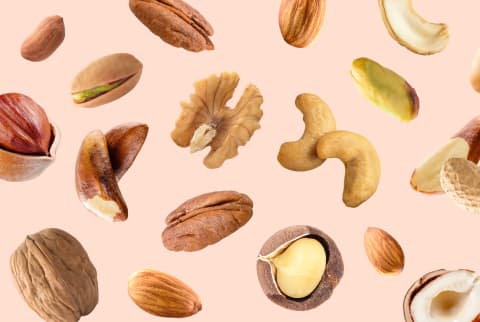Why Exactly Do We Eat Brazil Nuts? History + Health Benefits Of The Nutritious Seed


Seeds have played a pretty big role in the history of human nutrition. Seeds have been a life-sustaining food since ancient hunter-gatherer times, offering varying degrees of fat, protein, vitamins, minerals, and fiber, depending on the plant species.
One of these enduring food powerhouses is Brazil nuts—which, despite the name, are actually edible seeds from the Amazon Basin native Bertholletia excelsa tree.
A little background on Brazil nuts.
These seeds (or castañas in Spanish) come almost solely from lowland rainforests in South America, where Brazil nut trees grow abundantly wild and live for hundreds of years1.
Comparable in size to a coconut (weighing up to 6 pounds), the Brazil nut tree's fruit contains around 10 to 25 angular seeds, arranged like citrus segments within a larger pod.
History of Brazil nuts.
By the 17th century, Dutch traders had already introduced Brazil nuts to the world market, less than a century after Spanish and Portuguese explorers first came across these bitter-tasting seeds.
According to history writer David A. Taylor, officer Juan A. Maldonado and his troops were on a reconnaissance mission close to the Peruvian-Bolivian river Madre de Dios, when Cayanpuxes Indians told him about the nuts, which he called "almonds of the Andes." However, it wasn't until the Amazon river opened to foreign commerce in the 19th century that Brazil nut production rose extensively—coinciding with Brazil nuts' first official United States Customs entry in 1873.
Today, Bolivia, the largest Brazil nut exporter, accounts for 50% of the total world's harvest per the Observatory of Economic Complexity (OEC), followed by Brazil and Peru.
Health benefits.
These hearty seeds pack a lot of unique nutrients, and potential benefits for your health:
They're rich in selenium.
Brazil nuts are the highest known food source of selenium3, an essential trace element for the human body. Selenium can offer a number of potential health benefits (more on that below). Studies suggest that eating just two Brazil nuts a day4 can help you get adequate levels of this important nutrient.
It's important to note that you don't want to overdo it on selenium (symptoms can include rashes, dizziness, or more). So if you're eating a diet rich in other sources of selenium—such as yellowfin tuna, halibut, sardines, and oysters; pork; cottage cheese; and sunflower seeds—you may want to limit this nut in your diet.
They're nutrient-dense.
In addition to selenium, Brazil nuts' nutritional composition offers protein, fatty acids, fiber, and other bioactive compounds with associated health-supporting benefits5. They also contain a number of important micronutrients, such as magnesium, copper, and zinc, to name a few.
They support thyroid function.
"Brazil nuts are really rich in selenium, which is great for thyroid function," Vincent Pedre, M.D., previously told mindbodygreen. Research suggests supplementing with selenium may aid in thyroid balance6, whether you're trying to optimize thyroid function or you have a thyroid disorder. In fact, one study found that selenium supplementation may potentially improve reproductive outcomes and ease symptoms for women with PCOS7.
They're rich in antioxidants.
Brazil nuts contain antioxidants, including selenium, vitamin E, and phenols like gallic acid and ellagic acid—which may offer a number of benefits. Ellagic acid, for example, has anti-inflammatory properties, which can support brain health8. What's more, this seed can help support immunity9 since our immune system relies on adequate selenium intake.
8 Brazil nut recipes to try:

Ximena Araya-Fischel, M.A, is a journalist, IIN graduate integrative health coach, E-RYT 500 lead yoga teacher, and 500-Hour certified Pilates instructor from San José, Costa Rica. She received her master's degree in communication and journalism from The University of New Mexico, emphasizing well-being, sustainable fashion, health communication research, and graduating Summa Cum Laude. A former professional dancer, she's earned multiple academic and accredited certifications in performance design, positive psychology, doula training, entrepreneurship, digital marketing, mindfulness, innovation leadership, and integrative health. Her work has appeared at top consulting brands and organizations across Latin American and the US, including Byrdie and Albuquerque The Magazine. She currently lives between Costa Rica and New Mexico.
9 Sources
- https://link.springer.com/article/10.1007/s10531-017-1355-3#:~:text=Brazil%20nut%20trees%20can%20live,Salom%C3%A3o%201991%3B%20Peres%20et%20al.
- https://link.springer.com/article/10.1007/s11676-015-0037-9?shared-article-renderer
- https://www.sciencedirect.com/science/article/pii/B9780123756886100295
- https://pubmed.ncbi.nlm.nih.gov/18258628/
- https://www.sciencedirect.com/science/article/abs/pii/S096399691730474X
- https://www.ncbi.nlm.nih.gov/pmc/articles/PMC2721352/
- https://pubmed.ncbi.nlm.nih.gov/26267328/
- https://pubmed.ncbi.nlm.nih.gov/26846140/
- https://pubmed.ncbi.nlm.nih.gov/30200430/
